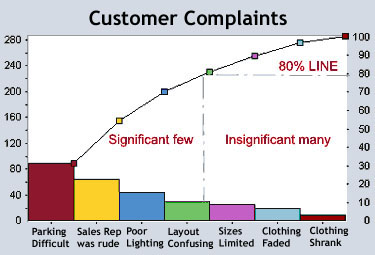WhatIs.com
Pareto chart (Pareto distribution diagram)
By TechTarget Contributor
A Pareto chart, also called a Pareto distribution diagram, is a vertical bar graph in which values are plotted in decreasing order of relative frequency from left to right. Pareto charts are extremely useful for analyzing what problems need attention first because the taller bars on the chart, which represent frequency, clearly illustrate which variables have the greatest cumulative effect on a given system.
The Pareto chart provides a graphic depiction of the Pareto principle, a theory maintaining that 80% of the output in a given situation or system is produced by 20% of the input.
The Pareto chart is one of the seven basic tools of quality control. The independent variables on the chart are shown on the horizontal axis and the dependent variables are portrayed as the heights of bars. A point-to-point graph, which shows the cumulative relative frequency, may be superimposed on the bar graph. Because the values of the statistical variables are placed in order of relative frequency, the graph clearly reveals which factors have the greatest impact and where attention is likely to yield the greatest benefit.
A Simple Example
A Pareto chart can be used to quickly identify what business issues need attention. By using hard data instead of intuition, there can be no question about what problems are influencing the outcome most. In the example below, XYZ Clothing Store was seeing a steady decline in business. Before the manager did a customer survey, he assumed the decline was due to customer dissatisfaction with the clothing line he was selling and he blamed his supply chain for his problems. After charting the frequency of the answers in his customer survey, however, it was very clear that the real reasons for the decline of his business had nothing to do with his supply chain. By collecting data and displaying it in a Pareto chart, the manager could see which variables were having the most influence. In this example, parking difficulties, rude sales people and poor lighting were hurting his business most. Following the Pareto Principle, those are the areas where he should focus his attention to build his business back up.

See also: flowchart, histogram
24 Mar 2011